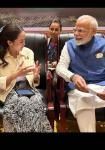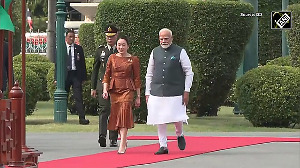'When George Bush Senior decided in 1992 that India and the United States must start talking in this-now-changed world, who would have thought that 10, 15 years down the road, we will start looking at each other as strategic partners?'

Rakesh Sood, retired career diplomat and one of the world's leading disarmament and non-proliferation experts, speaks to Aziz Haniffa/Rediff.com.
There have been Indian CEOs, entrepreneurs, some of whom have been gung-ho about the nuclear deal and see it as the centrepiece of the Indo-US strategic partnership.
But there are others who said, 'What's the big deal? Nuclear energy is going to be too expensive... US capital investment is going to be so great that it's not going to be feasible or financially viable to the Indian consumer.'
Some senior Obama administration officials are now advocating more for -- and US companies are pushing for -- renewables as a better energy option for India. What's your take on this?
First, you must understand that India is an enormously energy hungry society.
Our per capita energy consumption is a fraction of what the global averages are.
If we need to sustain growth rates of 7 or 8 per cent, we need to have energy expansion in generation capacity.
Second, there is a large part of the Indian population that does not have access to electric power.
Therefore, they use cow dung, firewood etc, which has its own implications. Here, we are not talking a few thousand people, we are talking several millions.
So, this has implications for climate change and global warming. Therefore, we need to expand our energy base.
Clearly, thermal has some limitations because of global warming concerns and things like that. Nuclear in that sense is clean energy, it is green energy.
Between 10 years ago and today the cost of renewables has come down in certain cases, but there are certain limitations: Whether renewables give you 24/7 energy or not.
Solar power does not give you 24/7, tidal, geothermal, wind, none of these give you 24/7. So you can't run industries on the basis of renewables.
Renewables can contribute in a big way if they are also financially viable. At the same time, nuclear has a role.
Given the fact that India is dependent on external sources -- since we do not have our own oil; we have a limited amount of gas -- we can keep importing large quantities of oil and gas.
We are already importing something like 75, 80 per cent of our requirements. This obviously has a foreign exchange dimension, on being a drain on reserves.
Therefore, we have to explore our own options and our own options of an energy mix, which is not going to exclude renewables in any way. Nuclear provides a regular supply, which is 24/7, and therefore it has applicability.
Considering the prohibitive costs of American reactors and then those suppliers and investors wanting a good profit on their investment to satisfy shareholders, is it a viable option, although the argument for nuclear energy could be a valid one?
Clearly, in addition to the reactors we may buy from Western sources or Russian sources, or the French or the Americans or elsewhere, we also have our own indigenous programmes.
We have set up 700 megawatt reactors and these are economically viable reactors.
Clearly, the reactors we may get from American companies would be of higher capacity and obviously, they are more modern, the technology would have additional safety features.
These reactors would be more expensive than the ones that we are making ourselves.
We will have to see how the costing of these works out. Presumably, they would also have longer lives.
So we have to look at how we amortise these costs over the life-cycle. Since we have a mature, developed, industry in India, some of the costs can be brought down if we start manufacturing some of the components within India.
The cost of production in India is much less than in the West, and we have found this in the defence industry. If we are going to get equipment from abroad, but part of it is going to be manufactured in India, then the overall cost of the equipment comes down.
Strobe (Talbott, currently the president of the Brookings Institution and former deputy secretary of state in the Clinton administration who was the US protagonist with erstwhile external affairs minister Jaswant Singh on the US-India Strategic Dialogue) always speaks highly of you, how integral your role was in the Strategic Dialogue -- that resurrected US-India relations after it took a nosedive after the May 1998 nuclear tests.
People like Swaminathan Aiyar, among others, argue that if India can't raise its per capita to at least $5,000 to $6,000 from its measly $1,500, all this talk of a strategic partnership is meaningless because it can never be a global player. Aiyar ridicules the strategic partnerships India has with several countries.
Is this so-called Indo-US Strategic Partnership, which had its beginnings in the Strategic Dialogue you were involved in, for real? Or it is quite a way off and depends a great deal on India's economic muscle?
The Indo-US Strategic Partnership is something which has grown gradually in the post-Cold War environment.
There are three fundamental factors driving it. The first is that the Cold War was over, and so this old ideological thing that India was aligned with the Soviet Union, that notion has been jettisoned.
It is very interesting that happened between then prime minister P V Narasimha Rao and President George H W Bush.
The senior Bush decided we must start talking in this-now-changed world. This was decided on during their meeting in 1992 in New York.
Political leaders understand the change of realities much faster than perhaps civil servants and bureaucrats because they are more attuned to these global changes.
At that stage would anybody have thought that 10, 15 years down the road, we'll start looking at each other as strategic partners?
Look at the way the language describing the relationship has shifted in the joint declarations and joint statements.
At the time, looking at India and the US, the general description was 'estranged democracies.' Then it became, with dialogue, 'engaged democracies,' then it became 'partnerships,' then it became 'indispensable partnerships for the 21stcentury,' 'defining partnership of the 21st century.'
So you see the weight that this relationship acquired, both in India as well as in the US. Driving this is, as I said, the end of the Cold War.
It is also that India is economically emerging and hopefully with high growth rates will continue to... will become a middle income country and all the rest of it.
The role of the Indian Diaspora in the United States has also contributed immensely to this partnership. The Indian Diaspora has through the 1990s seen a growth; its political profile has grown, which makes the US Congressman or the US Senator understand the importance of India much more, Modern India.
Suddenly, a different perception of India was created. Earlier, the perception of India was a country with the Taj Mahal. You went there to see that and you went to see forts in Rajasthan or beaches in Goa.
Now if you look at the flights between India and the United States, you find that more than half the guys travelling between India and the United States on any flight are doing it for business.
There is a new perception of India as a destination for investment, a destination for joint ventures. Mind you, it is two way.
You look at the Indian investment in the United States, the major companies from India, who have come and invested in the United States -- whether in engineering, whether in agriculture, whether in pharma, whether in IT, hotels...
It has become a relationship of a different order, and none of this is going to go into decline.
So naturally, the new terminology that is used of a 'defining partnership' or things like that is reflective of the reality today and the potential of this reality in five years, 10 years to come.
REDIFF RECOMMENDS
Image: Prime Minister Narendra Modi with US President Barack Obama at Hyderabad House in New Delhi, January 25, 2015. Photograph: MEA/Flickr











 © 2025
© 2025